Specifying and Verifying Collaborative Behavior in Component-Based Systems
Abstract
In a parameterized collaboration design, one views software as a collection
of components that play specific roles in interacting, giving rise to collaborative
behavior. From this perspective, collaboration designs revolve around reusing
collaborations that typify certain design patterns. Unfortunately, verifying
that active, concurrently executing components obey the synchronization
and communication requirements needed for the collaboration to work is
a serious problem. At least two major complications arise in concurrent
settings: (1) it may not be possible to analytically identify components
that violate the synchronization constraints required by a collaboration,
and (2) evolving participants in a collaboration independently often gives
rise to unanticipated synchronization conflicts. This paper briefly overviews
and summarizes a solution technique that addresses both of these problems.
Local (that is, role-to-role) synchronization consistency conditions are
formalized and associated decidable inference mechanisms are developed
to determine mutual compatibility and safe refinement of synchronization
behavior. It has been argued that this form of local consistency is necessary,
but insufficient to guarantee a consistent collaboration overall.
As a result, a new notion of global consistency (that is, among multiple
components playing multiple roles) is briefly outlined: causal process
constraint analysis. Principally, the method allows one to: (1) represent
the intended causal processes in terms of interactions depicted in UML
collaboration graphs; (2) formulate constraints on such interactions and
their evolution; and (3) check that the causal process constraints are
satisfied by the observed behavior of the component(s) at run-time.
Keywords
Verification, testing, reuse, collaborative behavior, synchronization,
parameterized collaboration.
Paper Category: technical paper
Emphasis: research
1. Introduction
Although a considerable amount of research has been devoted to component
and composition-based concepts and techniques, the impact of this technology
on component certification has yet to be fully explored. The clients of
reusable components will expect the parts they purchase and use to work
correctly with respect to their catalog descriptions in a given new context.
Therefore, a concrete component must be trustworthy; that is, it must correctly
implement the abstract service specification on which its clients will
depend. Since a reusable component is developed with specific contextual
assumptions and is unlikely to comply completely and without conflicts
with the domain of interest, the challenge of certification with reusable
components is far greater than that of conventional software. For tractability
purposes of assuring correctness of applications developed from reusable
components, local certifiability principles are advocated to facilitate
establishment of component properties outside of the context in which they
are embedded [Weide & Hollingsworth, 1992].
1.1 Local Certifiability Notion in Component-Based Systems
RESOLVE discipline provides a framework and language that facilitates achievement
of modular verification of correctness of functionality. The discipline
enables local or component-wise certification to demonstrate that a concrete
component (i.e., realization) achieves the functional behavior of its abstract
specification (i.e., concept). The certification is modular and local since
no assumptions or references are made with respect to the behavioral features
of clients. The composition of a component is argued to work correctly
as long as the clients interact with the reused component in conformance
with its expectations in a sequential context.
However, the verification as well as reuse of concurrent components
faces challenges not seen, for example, in most UI toolkits and data structure
libraries [Lea 1999]. Factors such as specification of design policies
(i.e., synchronous or asynchronous, local or remote, callback, forwarding,
or delegation), reflective, multilevel design (composite components), security,
safety, liveness, fault-tolerance, recovery policies make specification,
certification, and reasoning of reusable components difficult. Furthermore,
components cannot be built in isolation; instead, they must observe compatibility
constraints that are often phrased as architectural rules [Lea, 1999; Dellarocas,
1997] and synchronization constraints, especially in concurrent settings.
Development with reuse requires determining if the certified properties
and constraints of a component would facilitate its playing certain roles
to establish a specific purpose in the context into which it is embedded.
This paper briefly summarizes an approach, called collaborative behavior
verification, that aims to facilitate the examination of interaction dynamics
(synchronization constraints) of components in concurrent settings to assure
that they can fit and play the roles required by the parameterized collaborations
into which they are embedded.
1.2 The Terminology in Collaborative Behavior Verification
Approach
Software designs consist of components, roles, and, collaborations. Actors
that represent the components play roles collaboratively to implement collaborations.
Collaborations are descriptions of how a group of components jointly behave
when configured together in specific ways. A parameterized collaboration
represents a design construct that can be used repeatedly in different
component designs. The participants of the collaboration, including classifier
roles and association roles, form the parameters of the generic collaboration.
The parameters are bound to particular model elements in each instance
of the generic collaboration. Such a parameterized collaboration can capture
the structure of a design pattern. Each role is associated with a type
specification, called interaction policy. Interaction policies are language
independent specifications of external interface and visible synchronization
behavior that dictate the patterns of interchange of messages among collaborating
peers. A role describes a collaboration participant fulfilled by a specific
component when instantiated with a particular connector. Hence, a component
can play one or more roles. The context into which the component is embedded
needs to be aware of the assumptions, as shown in Figure 1, regarding the
correct usage of the component. The component also publishes its obligations
indicating that as long as the context uses the component in conformance
with its assumptions, it will guarantee the interaction behavior denoted
by the obligations.
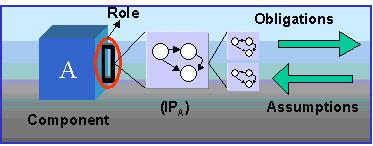
Figure 1: Assumptions and Obligations of a Role
This paper is organized as follows. In section 2 we identify and formulate
the problem. Sections 3 and 4 outline and summarize our approach to local
consistency, while section 5 is devoted to the global consistency
notion. In section 6, we overview the related work in collaboration design
and behavior verification. Finally, in section 7 we conclude and
discuss contributions of our work.
2. The Problem: The Local and Global Consistency Notions
of Collaborative Behavior for Parameterized Collaborations
In a parameterized collaboration design, one views software as a collection
of components that play specific roles in interacting, giving rise to collaborative
behavior. From this perspective, collaboration designs revolve around reusing
collaborations that typify certain design patterns. Each component in a
collaboration can have one or more roles. Unfortunately, verifying that
active, concurrently executing components obey the synchronization and
communication requirements needed for the collaboration to work is a serious
problem. At least two major complications arise in concurrent settings:
(1) it may not be possible to analytically identify components that violate
the synchronization constraints required by a collaboration, and (2) evolving
participants in a collaboration independently often gives rise to unanticipated
synchronization conflicts. These complications lead to the formulation
of the following questions that will be addressed in this dissertation:
-
Given generic parameterized collaborations and components with specific
roles, how do we verify that the provided and required synchronization
models are consistent and integrate correctly?
-
How do we guarantee that the synchronization behavior is maintained
and kept consistent with the collaboration constraints as the roles and
collaboration are refined during development?
-
How do we verify if the emergent cross-cutting synchronous causal behavior,
which arises due to the causal interference, interaction, and coordination
of components, is as intended? Furthermore, how do we determine whether
the coordination of roles played by each used component is evolved as expected
during the evolution of the collaboration as the system is maintained?
There are several questions that this research seeks to answer: Which representation
scheme and model should be used to represent synchronization contracts
(i.e., interaction policies) of a component at the abstract level? What
are the necessary and sufficient conditions and corresponding decision
procedures that facilitate tracking and maintaining semantic dependencies
between components based on the pertinent synchronization model? That is,
how do we verify that the roles integrate correctly, and how do we ensure
that the incremental enhancements to collaboration role models are consistent
with the original commitments made at previous levels of abstractions?
Furthermore, given that the used components fit into the roles expected
from them, is the actual emergent collaborative behavior, which arises
from the cascading of local interactions, achieved or evolved the way intended
by the designer?
2.1 Local Role Consistency in Collaboration-Based Software
Design
In the establishment of a market for software components, the separation
of specification and implementation is a well-known prerequisite.
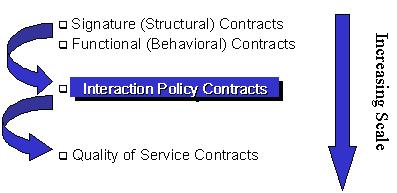
Figure 2: Reuse Contracts
Clients choosing the components based on their catalog descriptions
(i.e., contract specifications) expect them to behave correctly with respect
to their published contracts. In general, as shown in figure 2, contracts
can be divided into four main levels with increasingly negotiable properties
[Beugnard et al. 1999]. The first level, that of basic contracts,
is required to simply define the signature and types. The second level,
based on behavioral contracts, improves the level of client confidence,
particularly in a sequential context. The third level, emphasizing the
synchronization and interaction pattern contracts, improves confidence
particularly in concurrent and distributed settings. The fourth level,
quality of service contracts, quantifies the quality of service. Although
consistency notions exist for functional and structural contracts, still
missing with regard to collaboration-based software with collaborative
behavior reuse is a general consistency notion that emphasizes synchronization
contracts. Hence, determining methodologically whether the synchronization
constraints of used components’ roles fit into their local context (i.e.,
horizontal consistency) or are safely extended (i.e., vertical consistency)
is still an elusive goal.
2.2 Decision Procedures for the Analysis of Local Consistency
Conditions
Once functional and signature compatibility is established, synchronization
play a key role in assessing the fitness of components in a collaboration.
The preliminary analysis for synchronization fitness (consistency) of a
component is determined by its interaction policy compatibility with respect
to its context and depends on the interaction semantics under consideration.
Given the semantic domain used to express the synchronization consistency
conditions based on a certain interaction and request scheduling mechanism,
for correct realization, the next step involves developing decision procedures
to analyze the conditions mapped to the semantic domain. This involves
procedures determining (1) role compatibility (horizontal consistency),
(2) safe refinement (vertical consistency) of role and collaboration evolutions,
and (3) correct realization and implementation of the expected local role
interaction policies.
2.3 Causal Process Constraint Analysis for Achieving Global
Consistency
For achieving global consistency, analysis of local synchronization constraints
for horizontal and vertical consistency is necessary but insufficient.
This is due to the fact that the synchronization behavior of a role often
depends on other roles that, because of shared data state space and control
and data dependent causal connections, interfere with its interaction decisions.
Furthermore, for many component engineering tasks, including reasoning,
verification, and reuse, such causal connections depict why an artifact
is configured as it is. This is especially important when non-functional
aspects are derived from a particular design rationale based on certain
causal processes embedded in the collaboration. Hence, to achieve global
consistency, there is a need to provide methods for capturing, constraining,
and analyzing expected causal processes. Due to cascaded local synchronous
interactions, the emergent collaborative behavior designates how the component’s
behavior depends upon the composition of its constituent components and
how the component behavior is accomplished. Here, the conjecture asserts
that in order to verify that a component achieves its goal as intended
by the designer, one must show not only that the final expected condition
is satisfied but also that the components participated in the expected
causal process that resulted in the expected function. Hence, the causal
processes underlying the intended design patterns of the component designate
a certain aspect of the designer’s rationale and purpose to establish certain
non-functional as well as functional goals. In order to realize this rationale
and purpose it is essential to provide a means of (1) representing the
intended causal processes, (2) formulating constraints on causal processes
and their evolution, and (3) verifying whether the causal process constraints
are satisfied by the observed behavior of the component. In this
way, it would be possible to decide if the components (re)used in the intended
process work to achieve particular functional or nonfunctional goals.
3. Local Collaboration Consistency Notions using Concepts
of UML-RT
In this section the local consistency notion is illustrated in the context
of a collaborative behavior design. The utility of the methods is discussed
in the context of UML-Real Time (UML-RT), which is an extension of UML.
UML-RT places strong emphasis on UML collaboration concept, along with
notions of capsules, ports, connectors, protocols, and protocol roles.
Capsules are complex and potentially concurrent active architectural components.
They interact with their environment through one or more signal-based boundary
objects called ports. Collaboration diagrams describe the structural decomposition
of a capsule class.
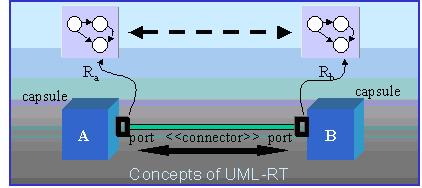
Figure 3: Components of UML-RT Role Models – The Local Perspective
Figure 3 illustrates the components of UML-RT role models. A port is
a physical part of the implementation of a capsule that mediates the interaction
of the capsule with the outside world—it is an object that implements a
specific interface. Ports realize protocols, which define the valid flow
of information (signals) between connected ports of capsules. A protocol
captures the contractual obligations that exist between capsules. Because
a protocol defines an abstract interface that is realized by a port, a
protocol is highly reusable. Connectors capture the key communication relationships
between capsules. Since they identify which capsules can affect each other
through direct communication, these relationships have architectural significance.
Collaboration diagrams, which capture architectural design patterns, are
used to describe the structural decomposition of a capsule class. They
use the primary modeling constructs of capsules, ports, and connectors
to specify the structure of software components. Capsules use ports to
export their interfaces to other capsules. The functionality of simple
capsules is realized directly by finite state machines, whose transitions
are triggered by the arrival of messages on the capsule's ports. Capsules
themselves can be decomposed into internal networks of communicating sub-capsules.
The state machine and network of hierarchically decomposed sub-capsules
allow the structural and behavioral modeling of arbitrarily complex systems.
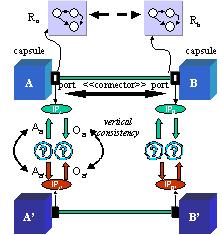
|
 |
Figure
4: Safe Refinement for Vertical Consistency
Figure 5: Horizontal Consistency
Given the formal models of assumptions and obligations, the horizontal
consistency refers to the compatibility of assumptions and obligations
of a port with respect to the obligations and assumptions of its peer capsule
port, as shown in Figure 4.
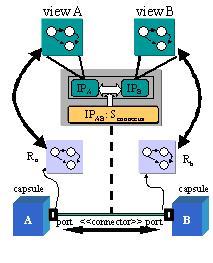
Figure 6: Connector Consistency
It is not always practical, however, to expect reused components
to be consistent with the context they are embedded. In such cases designer
develops a connector component that facilitates the mediation of interactions
between incompatible ports. Figure 6 denotes a connector projected onto
the viewpoints of the ports that it associates. Connector consistency entails
(1) the projection of the connector protocol onto its assumptions and obligations
with respect to each port and (2) horizontal consistency assessment between
the projected protocol and each connected port
Safe refinement, as shown in Figure 5, refers the consistency of the
original assumptions and obligations to the refined assumptions and obligations,
respectively, to assure that the refined component includes all the behavior
of the original role. The introduced consistency relation between the assumptions
and obligations need to be transitive and closed under the horizontal consistency
relation. Hence, as long as a component A' (abstract or concrete)
safely refines another component A, it can safely substitute A
without violating the originally commited assumptions and obligations.
4. Overview of Safe Refinement and Mutual Role Compatibility
of Interaction Policies
The certification model is based partly on the notion of augmenting an
abstraction refinement framework with concepts such as reusability and
interface compatibility. Formally representing the semantic dependencies
among abstract components and reasoning for their correct realization form
the basis of the certification model. Starting from the most abstract component,
the certification process for abstract components consists of two actions.
The first action determines the interaction policy compatibility of interaction
roles and the composition protocol consistency if a connector protocol
is declared, while the second ascertains whether the refined abstraction
is safe.
4.1 Safe Refinement of Role Interaction Policy Assumptions
The refinement of individual role interfaces is based simply on the implication
relation. Safe refinement of all roles of a particular component is essential
for safe refinement of a component. Conditions for the refinement are devised
such that the collaborating components would still be in agreement with
the refined interaction policies of the new role interface. We consider
two types of refinement, independent and simultaneous. Independent
refinement occurs when a single role interface is modified. Before mutual
compatibility of the refined role and its connected role interface can
be achieved, one must demonstrate that the refined role interface interaction
policies can at least engage in the expected interaction patterns, as dictated
by level of abstraction prior to refinement. Formally, the constraints
on the input patterns should be weaker, while the output constraints should
be stronger. Hence, the refined role interface would be able to accept
the expected input streams from its connection, as well as additional patterns
required by the refinement, while the outputs of the refined interface
should be acceptable by the input pattern assumptions of the connected
role interface. Furthermore, due to internal non-determinism of the finite
state abstraction of the protocol and interaction policies, those sets
of message traces or streams that fail to be accommodated by the refined
protocol must also shown to be failures in the original protocol. That
is, it is essential to incorporate failure semantics. The above argument
requires the refined interface to handle all the traces permissible in
the more abstract policy specification. Furthermore, all input/output stream
failures of the refined specification are also input/output failures of
the abstract specification. It is required that the output stream of the
refined policy to be equivalent to the output stream of the original interaction
policy under independent refinement. This condition is sufficient to ensure
that the output streams of the refined policy will be accepted by the receiving
role interface. In simultaneous refinement, the constraint on the set of
output streams of the refined policy is relaxed to incorporate additional
output streams. This relaxation must ensure, however, that the receiving
role interfaces and the composition protocol can consistently handle new
sets of output streams
4.3 Mutual Role Interaction Policy Compatibility
The role compatibility method uses semantic analysis to ensure the congruity
of connected role interface interaction policies. That is, interaction
policies of connected interfaces are checked to ensure that they are consistent
with each other. More specifically, collaborating components receive and
send messages in a synchronized manner; that is, when a collaboration mate
sends a message, the receiving party is shown to be in a state to receive
and act upon the message. To this end, each role interface declares the
set of input and output channels in terms of the provided (required) services
and the input (output) events. The services refer to bi-directional method
calls, whereas the events are unidirectional. The mutual role compatibility
condition formulation requires successful matching of (1) the provided
and required services and (2) the assumption and obligation constraints
of each role with respect to its peer. That is, the required services of
a particular role need to be a subset of the provided services of its mate.
Furthermore, the obligations of a role with respect to its mate should
be compatible with the assumptions of the mate component. More specifically,
the output stream constraints, called obligations, of a particular role
with respect to its mate need to match the trace constraints on or assumptions
about the input trace stream constraints of the mate component. Conversely,
the input stream trace constraints of the same role must comply with the
output stream obligation constraints of its mate. Note that the output
messages of a role interface are the input messages of its mate with opposite
directions.
4.4 Composition Protocol Consistency
Recent studies in component development and verification, as well as validation
processes, indicate that inconsistency is common throughout the development
and evolution stages. Inconsistencies occur because the reusable
components developed for different contexts have conflicting assumptions
with respect to each other. Basically, in our approach, protocol consistency
refers to the compatibility of the composition protocol with respect to
each of the role interaction policies. A composition protocol incorporates
all knowledge and rules regarding the means of coordinating and enacting
role interface interactions among the environment, component under certification,
and the associated peer components. In addition to identifying internal
rules used solely to regulate and adapt mismatched roles, it also stipulates
how and in which order the role enactment occurs. For each interaction
policy being tested by the mutual compatibility diagnosis, the composition
protocol consistency involves two stages. The first stage projects the
protocol onto the interaction policy services of the component and the
role interface services of the associated component or the environment.
The second stage consists of the mutual compatibility check, which
covers the projected interaction constraints imposed by the protocol and
the interaction policy constraints of the connected role. The composition
consistency rules indicate three requirements. First, the collaboration
mate must provide every service required by a role. Secondly, the output
channel obligation constraints of the projected role must be compatible
with the input assumptions constraints of the role interface under consideration.
Finally, the output channel obligation constraints of the role under consideration
must be compatible with the input assumption constraints of the projected
role interface derived from the original protocol.
5. How Components are Intended to Work and Evolve: Causal
Process Constraint Analysis
How components are configured and composed determines the organizational
behavior that will emerge from the conglomerates of local interactions.
Due to the state space explosion problem, deriving from the set of local
interactions a causal behavioral model depicting the computational paths
is very expensive. Hence, a new technique, which can be categorized as
hybrid simulation verification, is developed. By synthesizing an intermediate
analysis method, this technique combines the best of both worlds of run-time
testing and verification. It uses test scenario execution to drive the
component with a test engine that emulates the context of the component
under certification. Test scenario execution also limits the generation
of causal computation graphs to the computations consistent with the run-time
behavior. This limited computation graph, called the causal behavior model,
can be orders of magnitude smaller than the potential graph that could
be derived from analyzing the local interaction policies of roles.
5.1 Causal Process Constraint Specification Approach
Local interaction policies consider those roles with pair-wise local connections
that are associated with interaction constraints. They can be considered
as local integration dependencies between constituent components implementing
provided and required roles. In the context of the collaboration under
certification, the cascading of these local dependencies leads to the emergent
global integration behavior of the constituent components.
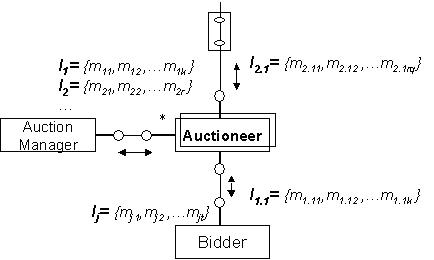
Figure 7: Causal Interaction Sequence Derivation from Collaboration
Graphs
Such global integration constraints are considered under the horizontal
integration aspect by utilizing mechanisms (i.e., UML collaboration graphs)
to specify the processes underlying the computations. This section introduces
a graph-oriented representation of causal event sequences based on the
UML collaboration graphs. A simple constraint language is provided to enable
the designer to constrain the expected causal process patterns and their
evolution. Figure 7 depicts the interaction aspect of a collaboration that
is utilized to capture causal processes that cross-cut the participant
components. Each interaction constitutes a sequence of messages exchanged
between a pair of connected roles. In figure 7, the overall interaction,
I=
{I1, I1.1, I2, I2.1 …Ij},
is decomposed into subinteractions such as I1, I1.1,
I2, I2.1 …Ij, each of which constitutes
message exchanges between peers. Note that UML collaboration interaction
semantics provides a precedence relation (i.e., partial order) among the
interactions. That is, the interaction identifiers that are distinguished
in one integer form (i.e., 1, 1.1, 1.1.1, 1.1.2, 1.1.3 and
1, 1.2, 1.2.1, 1.2.2, 1.2.3 are two such sequences) constitute a
sequence of interactions. The interaction sequences discussed above can
be viewed as directed acyclic graphs, with the nodes representing the events
and the arcs representing the causal relationships among them. This representation
makes it possible to distinguish between roles that interact and those
that do not.
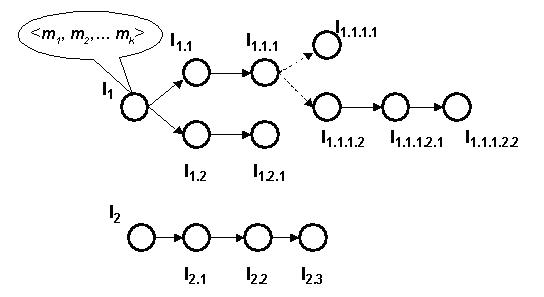
Figure 8: Causal Interaction Sequences
The interaction sequencing rules of UML collaboration graphs are represented
in terms of And-Or graphs that are directed and acyclic, as shown
in Figure 8. These graphs are called causal interaction graphs. Each causal
interaction graph defines a single causal process. Each root-to-leaf sequence
of interactions is called a causal interaction sequence. Causal processes
are the expected computations that underlie services delivered by the collaboration.
The processes constrain the overall computation space by imposing a specific
causal pattern of interaction sequences. However, by themselves, causal
processes cannot relate their occurrence to the existence of other causal
processes and cannot represent the evolution of the collaborations. That
is, operators and further constraints are needed to determine whether the
occurrence of causal processes are temporally or logically related to each
other, as well as if the causal processes evolve as intended. Such
properties can be extended to check for interesting properties in the overall
causal event streams. Below, the syntactic grammar of temporal, logical,
and boolean operators on causal processes are presented:
Constraints ::= constraints ‘:’ CPDSet
CPDSet ::= CPD CPDSet | CPD
CPD ::= (always |sometimes)
Cpat | (introduce | prevent | guarantee) CPat
CPat ::= CedP | (until | unless|
since)
(CedP, CedP)
CedP ::= Ced or CedP | Ced
Ced ::= cedName and
Ced | cedName implies cedName | cedName
The constraints involve existential quantifiers (always, sometimes), evolution
operators (introduce, prevent, guarantee), temporal operators (until, unless,
since), and Boolean operators (or, and, implies). The semantics of the
operators are beyond the scope of this short paper and will be presented
elsewhere.
5.2 Overview of the Causal Process Constraint Analysis
Once a causal behavioral model is generated from the raw run-time interaction
logs of a collaboration, constraint analysis is performed to determine
if the run-time behavior satisfies causal process constraints. Due to space
limitations we are omitting the causal behavioral model derivation and
underlying causal event model here. In this section we briefly summarize
constraint analysis mechanism.
As mentioned above, the constraints against which the derived causal
behavioral model is checked impose temporal, evolution, and logical relationships
on the observed causal processes. The execution of each single test scenario
results in a set of observed causal process sequences. Constraint operators,
such as always and sometimes, help the designer decide if the certain causal
processes that are observed under all interaction scenarios enacted during
the run-time monitoring process are invariant. On the other hand, the evolution
operators involve comparisons of successive versions of the collaborative
behavior under the same test scenarios. The temporal operators, as well
as the boolean operators, impose a set of causal process patterns. The
results of the application of operator rules to satisfiability vectors
for each operand of the constraint tree are then combined to derive a global
result for quantifier and evolution constraints.
Once the behavioral models for each exercised interaction scenario are
derived and transformed into causal process sequences using the introduced
event causality model, one can view the complete observed behavior of the
component as a behavior matrix. The rows and columns of this matrix represent
the exercised scenarios and the causal process sequences derived from the
behavioral model with respect to the corresponding scenario. Formally,
the behavior matrix is a two-dimensional m x n matrix, called BM.
Here,
m stands for the number of scenarios exercised, and n
stands for the largest in cardinality of the set of causal process sequences
derived as a result of each scenario. Each cell of the matrix is denoted
as Pi,j, where i stands for the ith scenario
and j stands for the jth sequence in the set, Pi,
of causal process sequences associated with the scenario i. Hence,
Pi,j
stands for the jth sequence of the causal process sequence set
of the ith interaction scenario observed during run-time monitoring.
After defining a matrix-oriented representation of the behavioral model,
the next step is to test if the generated model satisfies constraints placed
upon it. To determine if such constraints are satisfied, the
approach requires a computational model to represent the constraints, as
well as methods and reasoning mechanisms regarding their satisfiability.
To this end, the constraint tree formalism is introduced.
Definition: A constraint tree, CT, is a finite set of
one or more nodes such that there is one designated node R called
the root of CT. The remaining nodes in CT –{R} are
also partitioned into n > 0 disjoint subsets CT1, CT2,
…, CTn, each of which is a tree, and whose roots R1,
R2, …, Rn, respectively, are children of R.
The leaf nodes that have out-degrees of zero are causal processes and the
internal nodes that have out-degrees of one or more are the operators of
the constraints.
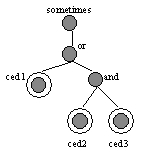
Figure 9: Constraint Tree
Constraint tree derivation: Consider the tree representation,
shown in Figure 9, of the constraint sometimes (ced1 or ced2 and ced3).
The constraint is parsed according to the constraint grammar to produce
an abstract syntax tree for the in-order representation. Then, the tree
is traversed to derive a pre-order representation of the constraint statement:
sometimes
or ced1 and ced2 ced3. Then the pre-order sequence is used to form
the constraint tree in a top-down manner.
Causal Process Analysis Summary: Causal process analysis constitutes
the methods that check for the satisfying of constraints represented in
constraint tree formalism against the behavior matrix BM = (Pi,
j) for i =1,2,…m and j = 1,2,…,k as discussed above.
The satisfying of a constraint for the recognized causal process sequences
of a scenario is represented as a boolean vector. Hence, a two dimensional
boolean matrix,
SAT = (bi,j) for i =1,2,…m
and j = 1,2,…,k is used for all interaction scenarios used in the
certification. Each boolean vector for a given interaction scenario constitutes
a row of the boolean matrix. We demonstrated the methods that check the
satisfying of constraints against the derived causal process sequences
of a particular scenario. The same method is applied for each scenario
to generate the complete boolean matrix. Let BMi denote the
ith row of the behavior matrix, which represents the set of causal
process sequences captured as a result of the ith interaction
scenario. Similarly, SATi denotes the boolean
vector that stores the computed boolean value denoting the satisfying of
each constraint by the sequences of the ith scenario. SATi
is computed gradually, using the constraint tree and the set of causal
process sequences associated with the BMi. Using the
constraint tree, the satisfiability vector is constructed from the bottom
up. Initially, each leaf node of the constraint tree is associated with
a boolean vector denoting the causal process sequences that satisfy the
causal event description depicted at that node. As the rules associated
with the operators at the internal nodes are applied to the vectors of
its children the derived vectors are propagated upward in the tree to generate
a new global boolean vector. The rules for each operator is derived using
its semantics. The resulting boolean vector at the root of the constraint
tree represents the satisfiability of the constraint with respect to the
behavioral model derived after the execution of a given test scenario.
6. Related Work
A variety of research groups have recently investigated the compositional
verification of collaboration designs. To prove certain behavioral properties
about individual and composition of collaborations, some of these groups—such
as Fisler and Krishnamurthi [2001]—employ finite state verification. Others,
such as Engels, Kuster, and Groenewegen [2001], use CSP-type process-oriented
formalisms to analyze object-oriented behavioral models for certain consistency
properties. The interface automata concept introduced by Alfaro and Henzinger
[2001] investigates light-weight formalisms that capture the temporal aspects
of software with an approach the authors call optimistic view. Additionally,
Butkevich, et al. [2000] describe an extension of the Java programming
language that supports static interaction conformance checking and dynamic
debugging of object protocols. Their approach considers only the incoming
requests and omits the output obligations of components, as well as global
causal processes. Also, the UML model integration testing approach
discussed by Hartman, Imoberdorf, and Meisinger [2001] illustrates the
issues involved in collaboration testing.
7. Conclusions
In this paper we briefly overviewed and summarized an approach to consistency
analysis and management for synchronization behavior in parameterized collaborations.
Local (that is, role-to-role) synchronization consistency conditions are
formalized and associated decidable inference mechanisms are developed
to determine mutual compatibility and safe refinement of synchronization
behavior. It has been argued that this form of local consistency is necessary,
but insufficient to guarantee a consistent collaboration overall.
As a result, a new notion of global consistency (that is, among multiple
components playing multiple roles) is briefly outlined: causal process
constraint analysis. Principally, the method allows one to: (1) represent
the intended causal processes in terms of interactions depicted in UML
collaboration graphs; (2) formulate constraints on such interactions and
their evolution; and (3) check that the causal process constraints are
satisfied by the observed behavior of the component(s) at run-time.
References
[Alfaro de L., T. A. Henzinger 2001].
“Interface Automata,” Software Engineering Notes, vol. 26, no.5, pp.109-129.
[Beugnard A., J.-M. Jezequel, N. Plouzeau, and D. Watkins 1999].
“Making Components Contract Aware,” IEEE Computer, vol. 32 no.7, pp. 38-45.
[Butkevich S., M. Raneco, G. Baumgartner, M. Young 2000],
“Compiler and Tool Support for Debugging Object Protocols,” Software
Engineering Notes, vol. 25 no. 6, pp.50-59.
[Dellarocas C. 1997].
“Software Component Interconnection Should Be Treated as a Distinct Design
Problem,” In Proceedings of the 8th Annual Workshop on
Software Reuse (WISR), Columbus, Ohio, March 23-26, 1997.
[Engels G., J. M. Kuster, L. Groenewegen. 2001].
“A Methodology for Specifying and Analyzing Consistency of Object-Oriented
Behavioral Models,” Software Engineering Notes, vol. 26,
no.5, pp.186-195
[Fisler K. and S. Krishnamurti 2001].
“Modular Verification of Collaboration-Based Software Design,” In Proceedings
of the 8th European Software Engineering Conference,
pp. 152-163.
[Lea D. 1999].
“Complex Components Create New Challenges,” In Proceedings of the 9th Annual
Workshop on Software Reuse.
[Weide W. B. and J. E. Hollingsworth 1992].
“On Local Certifiability of Software Components,” In Proceedings of the
5th Annual Workshop on Software Reuse.